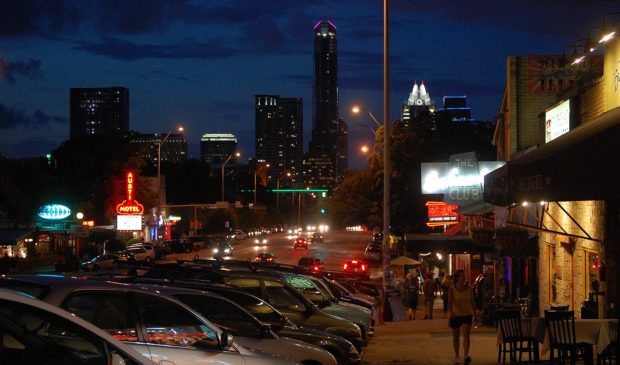About the Author
Chad Swiatecki is a 20-year journalist who relocated to Austin from his home state of Michigan in 2008. He most enjoys covering the intersection of arts, business and local/state politics. He has written for Rolling Stone, Spin, New York Daily News, Texas Monthly, Austin American-Statesman and many other regional and national outlets.
Newsletter Signup
The Austin Monitor thanks its sponsors. Become one.
Most Popular Stories
- Parks Board recommends vendor for Zilker Café, while voicing concerns about lack of local presence
- Office slowdown sparks new downtown housing ambitions
- City leaders evaluate surprising ideas for water conservation
- Audit: Economic official granted arts, music funding against city code
- Downtown Historic Resource Survey eyes seven new districts eligible for designation
-
Discover News By District
Popular Whispers
Sorry. No data so far.

Austin looks to other music cities as ‘agent of change’ ordinance develops
Tuesday, December 4, 2018 by Chad Swiatecki
If Austin is to make real progress in its new round of trying to pass an ordinance intended to calm noise complaints between residential buildings and entertainment venues, a number of lingering issues from the shelved 2017 effort will have to be resolved. Among them: how to properly enforce the city’s sound ordinances in popular music and entertainment districts, and to what degree developers and residents of condominiums and hotels bear responsibility for coexisting with music venues that may predate new surrounding construction.
Those were two of the matters discussed last week when the city’s music office hosted a “best practices” teleconference with city officials in Toronto, San Francisco and Brisbane, Australia.
Like Austin, all three cities experienced friction between venues and the residential developments they tend to attract, with noise complaints spiking as a result. The representatives shared strategies that included a mix of adjusted or flexible noise limits around venues, increased building requirements for new projects near licensed venues, and agreements about expectations for both sides.
Brisbane’s 2006 policy has had a dramatic effect on the city’s five entertainment zones, with the number of music venues growing from 30 to more than 50 and economic growth in those areas more than double that of the rest of the city.
“In terms of compliance, the operator can monitor easily because they know what (sound) level to achieve,” said Frank Henry, Brisbane’s program manager for pollution control.
“It also allows new venues to open up easily because a new venue knows it has to achieve 90 decibels at its boundary. It’s made it easy for a whole range, so we’ve got small venues and rooms for up to 100 people, up to large venues for a couple thousand, and having that performance expectation specified up front in the noise laws means that a venue can open with certainty.”
Austin’s City Council voted to relaunch its so-called “agent of change” ordinance process this fall, with the goal of bringing local music venues, neighborhood groups and the city’s hotel industry leaders to consensus on a policy that can be enacted next year. A community forum to discuss the policy proposal will take place at 3 p.m. today Wednesday at the Doris Miller Auditorium on Rosewood Avenue.
The cities involved in the discussion used a mix of special commissions or boards charged with addressing issues related to music and entertainment venues, with some having the power to give notes and add requirements to development proposals that are judged to have a possible impact on those culturally important businesses.
In Toronto, which passed a strategic plan for its music community in 2016, there is also concern that economic issues added to noise complaints could further threaten the thin-margined businesses. Because of that, steps are being taken to allow music venues in cheaper areas zoned for industrial use. Toronto is also examining creating a specific license for music venues that could carry some protections from noise complaints.
“We are looking at if some areas zoned industrial could have flexibility to permit venues, because rising land values force music venues out of the very expensive area,” said Mike Tanner, Toronto’s music sector development officer. “If we don’t look for ways to help move music venues to those areas, we run the risk of losing them to other nearby cities.”
The panel also celebrated one of Austin’s recent successes in the ever-changing music landscape: the Red River pilot program that created later noise curfews for outdoor music venues, allowing them to generate more liquor sales revenue on busy nights.
Steve Tomlinson, vice president of the North University Neighborhood Association, said the collaboration process between venue operators and nearby residents has shown that the city can preserve quality of life and its nightlife.
“The exciting thing about these collaborations was problem-solving that was data-driven, and looking for ways to make each other successful,” he said. “It was exciting to figure out that an extra hour was so valuable they were willing to do so much to improve neighborhood quality of life to get that.”
Photo by LoneStarMike [CC BY-SA 3.0], from Wikimedia Commons.
The Austin Monitor’s work is made possible by donations from the community. Though our reporting covers donors from time to time, we are careful to keep business and editorial efforts separate while maintaining transparency. A complete list of donors is available here, and our code of ethics is explained here.
You're a community leader
And we’re honored you look to us for serious, in-depth news. You know a strong community needs local and dedicated watchdog reporting. We’re here for you and that won’t change. Now will you take the powerful next step and support our nonprofit news organization?


